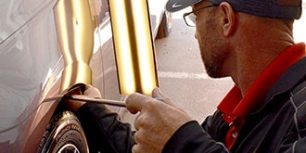Every single day, approximately 2,000 workers suffer from a job-related eye injury that requires medical attention. Beyond the immediate, physical effects, eye injuries can lead to costly outcomes for everyone involved, including shift supervisors, plant managers, and company executives. The good news is, nearly 90% of all workplace eye injuries can be prevented with the right protective eyewear and safety measures.
No matter what industry you’re in, committing to safety is a number one priority. Continue reading to learn how you can prioritize eye safety at work and reduce the risk of job-related eye injuries.
What Can Cause Eye Injuries at Work?
In the automotive and manufacturing industries, the work environment is filled with potential hazards that can cause serious injuries, especially to the eyes. Understanding these risks is the first step toward prevention. There are many risks to be aware of, including:
Flying Particles
The most prevalent source of eye injuries at work comes from particles such as metal shavings, wood chips, glass, and other debris. In fact, 70% of all workplace accidents were caused by flying or falling objects and sparks hitting the eye. Whether drilling, sanding, or hammering, these activities can project tiny, sometimes microscopic fragments into the air at high speeds, posing a significant risk to your eye health.
Contact with Chemicals
Automotive fluids like oil, coolant, and especially corrosive substances such as battery acid can cause devastating eye injuries if splashed or sprayed onto the eyes. Liquid and vapors cause 20% of auto shop eye injuries, not only posing a risk to immediate injury but also leading to long-term vision problems if not properly managed.
Falling Items
Working near the floor underneath or alongside a vehicle can lead to the risk of falling objects. Any items left unsecured on overhead shelves or lifted vehicles can become significant hazards if they fall, as a tool or part dropping from even a moderate height can cause serious eye injuries. Beyond the direct impact, falling items can propel fragments or debris outward when they hit another surface, leading to the potential for further eye injury.
Small Explosions
In automotive repair, working with vehicle batteries, electrical components, and flammable substances increases the risk of small explosions. Batteries may explode during charging, tires may pop, and explosions may occur when removing or attaching pressurized air tools. Even a minor explosion can project shrapnel and hot debris into the air at high speeds, posing a severe risk to the eyes.
Lack of Attention
In busy environments like auto shops, a lack of attention can lead to serious injuries. While it’s always encouraged to keep your shop clean, it’s not always possible to keep the shop floor spotless on busy days. Tripping over tools, parts, equipment, hoses, or wires on the floor can lead to significant eye damage or other bodily harm.
How Can You Prevent an Eye Injury at Work?
Preventing eye injuries in the automotive industry is about more than just watching your step; it involves a combination of proper personal protective equipment, workplace safety practices, and awareness training. Here are the three primary steps to enhancing your eye safety at work:
1. Protect
The first and most important step is to ensure that all technicians have properly-fitting protective eyewear. Before beginning any tasks, assess the potential eye hazards and choose appropriate eyewear to protect against them. This may vary between safety glasses, goggles, face shields, or welding helmets based on the level of risk. No matter the eyewear you choose, it should fit comfortably and securely, with no gaps that particles can enter through.
2. Participate
Proper eye protection should be mandatory at all times, as OSHA and state-level programs require it. Use clear, visible signs to remind workers of the need to wear eye protection and mark areas where additional hazards or specific types of eyewear are required. For further protection, technicians should also regularly clean work areas to minimize dust and debris, and should ensure all tools and materials are properly stored when not in use. Finally, regularly inspect and maintain all equipment and tools to prevent malfunctions and failures that could lead to eye injuries.
3. Plan
Even with the most stringent safety protocols in place, eye injuries can still occur in the workplace. Ensure you have a robust emergency plan in place for eye injuries, training all employees on these procedures and the steps they should take if they experience an injury. You should also educate your technicians on how to correctly use tools and handle chemicals, emphasizing the importance of eye protection during these activities.
Types of Personal Protective Eye Equipment
For automotive technicians, the risk of eye injury can be significantly reduced by using the correct personal protective equipment (PPE). There are various types of PPE available, with each having unique benefits and features for specific tasks. Common types of PPE used in auto shops include:
- Safety Glasses: While they look like regular eyeglasses, safety glasses are designed to provide strong resistance against impact and often feature side shields to protect against debris entering from the sides. This type of PPE is ideal for general tasks where light debris, dust, or splashes are a concern but where there is minimal risk of high-velocity impact or chemical exposure.
- Goggles: Goggles provide a secure fit around the entire eye area, protecting from all angles. They are particularly effective against dust, splashes, or hazardous chemicals, and are recommended for tasks that involve chemical handling or when sealed protection is needed against dust and fine particles.
- Face Shields: This type of PPE covers the entire face to provide a barrier against large particles, splashes, and harmful heat exposure. They are generally worn over other eye protection, like safety glasses or goggles, and are essential for activities such as grinding, cutting, or when working with chemicals.
- Welding Helmets: These specialized helmets are equipped with filter lenses that protect eyes from the intense light and UV radiation produced by welding operations. They also shield the face and neck against sparks and molten debris. Welding helmets are mandatory for any type of welding work, including arc, MIG, and TIG welding, to protect against ultraviolet and infrared emissions.
What to Do if an Eye Injury Occurs
Despite taking all the necessary precautions, accidents can still happen, and knowing how to respond when an eye injury occurs at work is essential. Immediate and correct action can prevent further harm and promote better recovery outcomes. If you experience an eye injury in the workplace, here’s what you should do:
Provide Immediate First Aid
No matter what type of injury occurs, it’s crucial that you begin first aid measures right away. First and foremost, do not rub they eye, as this can exacerbate the injury. You should immediately flush the eye at an emergency eye wash station or with a portable eyewash bottle, keeping your eye open as wide as possible while flushing for at least 15 minutes (taking small breaks as needed). If you are wearing contact lenses, you should flush over the lens, even if it gets washed out of your eye.
Report the Injury
Your immediate supervisor should be notified of the injury as soon as possible. If available to you, you should also report the eye injury via an Incident Report or through your company’s dedicated Safety Portal to ensure all relevant parties are aware of the incident.
Seek Medical Attention
While it’s always recommended that you visit an eye specialist or medical professional after a work-related eye injury occurs, it’s vital to seek medical attention if the injury is caused by large flying objects or contact with chemicals. Even if the injury appears minor, it may lead to complications or vision loss if not properly treated.
Prioritize Eye Safety at Work in the Automotive Industry
Maintaining eye safety at work in the automotive industry is not just a regulatory requirement, but also a critical component of protecting employees’ well-being and maintaining productivity. Every step taken towards improving eye safety—from selecting the correct protective gear and maintaining a tidy work environment to implementing comprehensive safety training—contributes to a safer and more efficient workplace.
By fostering a culture that prioritizes eye safety, automotive businesses not only comply with legal and ethical standards but also invest in their most valuable asset—their people. With the right plans, awareness, and PPE, you can ensure that all technicians return home without an injury.
How is your shop prioritizing eye safety at work? Share your thoughts, best practices, and success stories with us on Facebook and X (formerly Twitter), and stay up-to-date on the latest insights from Dent Wizard, the world leader in automotive SMART repairs.





